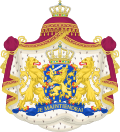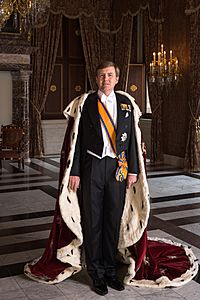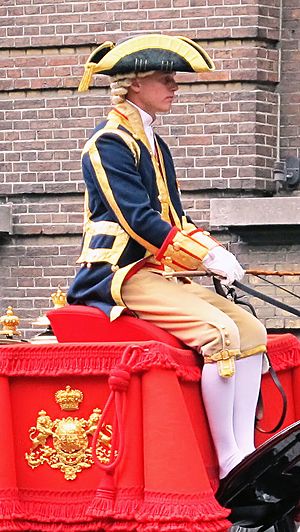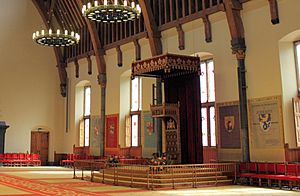Monarchy of the Netherlands facts for kids
Quick facts for kids King of the Netherlands |
|
|---|---|
| Koning der Nederlanden Rey di Hulanda |
|

|
|
| Incumbent | |
 |
|
| Willem-Alexander since 30 April 2013 |
|
| Details | |
| Style | His Majesty |
| Heir apparent | Catharina-Amalia, Princess of Orange |
| First monarch | William I |
| Formation | 16 March 1815 |
| Residence |
|
The monarchy of the Netherlands is how the country is led by a King or Queen. This system is guided by the country's main rules, called the Charter and the Constitution. These documents explain how a new King or Queen takes the throne, what their jobs are, and how they work with the government. The monarch is the head of state, which means they are the official face of the country.
For a long time, parts of the Netherlands were ruled by members of the House of Orange-Nassau. This started in 1559 with William the Silent, who was a special leader called a stadtholder. He led the Dutch Revolt and helped create the independent Dutch Republic. Later, his family members became stadtholders too, and by 1747, this role became something passed down through families.
The Kingdom of the Netherlands became a monarchy on November 20, 1813, after the French rule ended. It officially became a kingdom on March 16, 1815. Today, Willem-Alexander has been the King of the Netherlands since April 30, 2013. He became King after his mother, Queen Beatrix, decided to step down.
Contents
- Becoming the Monarch
- The Monarch and the Government
- The Monarch and the Law
- Forming the Government
- The Monarch and Parliament
- Other Roles of the Monarch
- Other Members of the Royal Family
- History of the Monarchy
- Religious Beliefs
- Royal Finances
- Monarchs of the Netherlands
- The Royal Family and the Royal House
- See also
Becoming the Monarch
The job of monarch in the Netherlands is passed down through the family of William I. This is called succession. The rules for who becomes monarch are based on two main ideas:
- Absolute primogeniture: This means the oldest child inherits the throne, no matter if they are a boy or a girl. This rule started in 1983.
- Proximity of blood: Only people closely related to the current monarch can inherit the throne. For example, if you are a great-grandchild of a former Queen, you might not be in line for the throne.
Also, only children born within a marriage can become monarch. If a King dies and his wife is pregnant, the unborn child is immediately considered the heir. If the baby is stillborn, it's as if they never existed for the line of succession.
If the monarch is a child, a special person called a regent is chosen to rule until the child is old enough. Usually, this is the child's parent.
There are also special rules for who cannot become monarch:
- If an heir marries without the permission of the States-General (the Dutch Parliament), they lose their right to the throne.
- If someone in line for the throne becomes truly unsuitable, Parliament can remove them. This is like an emergency rule and has never been used.
Taking the Throne
The Netherlands always has a monarch. The country's rules say there can't be a time when there is no King or Queen. This is because the government needs a head of state to work properly. So, when the old monarch stops ruling, the new one takes over right away.
The new monarch must promise to follow the Constitution and do their job well. This promise is made during a special ceremony called an inauguration (inhuldiging). This ceremony happens in Amsterdam, which the Constitution calls the capital city.
The Dutch monarch is not crowned with a physical crown. Instead, their promise to serve the country is what makes them the monarch. The crown and other royal items are there, but they are not placed on the monarch's head. The new monarch starts ruling the moment the previous one stops. The ceremony is just a public way to show they have accepted the role.
When a Reign Ends
A monarch's rule can end in two ways:
- Death: The monarch passes away.
- Abdication: The monarch decides to step down.
Both events trigger the rules for succession. When a monarch steps down, they cannot return to the throne. Also, any children born to them after they step down cannot claim the throne.
After stepping down, a former monarch is legally called a Prince or Princess. However, after they pass away, people traditionally refer to them as King or Queen again. For example, Queen Juliana became a Princess after she stepped down in 1980, but after her death in 2004, she was called Queen Juliana again.
Temporary Loss of Power
Sometimes, a monarch might temporarily stop doing their royal duties. This can happen in two ways:
- Voluntary suspension: The monarch chooses to stop for a while.
- Removal: The government decides the monarch is unable to do their job.
These situations are temporary. They are meant for emergencies, like if the monarch becomes very sick or has a mental health issue. In both cases, the Parliament must agree to this change. If the monarch steps down temporarily, they sign a law. If they are removed, Parliament makes a special declaration.
When this happens, a regent is chosen to rule instead. This is usually the heir to the throne if they are old enough. For the monarch to return to their duties, a new law must be passed.
The Monarch and the Government
The monarch has important roles in the government, especially in the executive branch. This means the King or Queen is part of the government of the Netherlands.
The Constitution says two key things about this:
- The government is made up of the King and the ministers.
- The King cannot be blamed for anything; the ministers are responsible.
This means the King is protected from legal trouble for his actions as monarch. But it also means the ministers are the ones who make the real decisions. The government works as one team. If the King acts, he does so for the whole government. Even if the King personally disagrees with a decision, he must go along with what the ministers decide. This means the King cannot refuse to sign a law that the responsible minister has approved. If he did, it would cause a big problem for the country.
In modern times, the King has very little actual political power. Ministers make the big decisions and run the country. The King rarely speaks in public about politics, unless he is reading a statement written by the Prime Minister. Every decision and law must be signed by the King and also by the responsible minister. This makes sure the minister is politically responsible for the action.
The Monarch and the Law
The monarch has a lot of formal power. For example, no law can start until the King signs it. Even though he doesn't have to sign, he always does. This is because most laws are proposed "by or on behalf of the King" by the government.
Many things are also done through royal decrees (Koninklijk Besluit). These are used for many things, like appointing government workers, explaining how policies should work, or even dissolving parts of Parliament.
However, these royal decrees are actually made by the responsible minister. The King must sign them, but the minister or a state secretary must also sign them. This makes sure that the minister is responsible, not the King. The King signs first as a guardian of the Constitution, and the minister's signature confirms responsibility. The King doesn't actually propose laws himself. It would be a big problem if the King refused to sign a law that Parliament had approved.
There's a special rule for appointing ministers. The royal decree to appoint a minister needs to be signed by two ministers: the outgoing minister and the Prime Minister.
Forming the Government
Even though the monarch's powers are limited, they have an important role after parliamentary elections when a new government needs to be formed.
After an election, different political parties in Parliament try to form a group that has enough support to lead the country. Because many parties usually win seats, it's almost impossible for one party to win a majority on its own. So, parties have to work together to form a coalition. This process can take a few months.
In the past, the monarch appointed special people called informateurs and formateurs. The informateur would explore which parties could work together. Once a good combination was found, a formateur was appointed to lead the actual talks and form the new government. This formateur usually became the Prime Minister. The monarch made these appointments based on advice from party leaders and other important people.
There used to be discussions about whether the monarch should have this power, as some felt it was not democratic. However, the monarch usually chose neutral people for these roles.
In March 2012, Parliament changed its rules so that the monarch would no longer be involved in forming the government. Instead, the Speaker of the House of Representatives now appoints the "scout" (the new name for informateur). The installation ceremony for ministers, which is the only duty left for the monarch in this process, is now held in public.
The Monarch and Parliament
The monarch has no direct control over the Parliament, which is called the States-General of the Netherlands. This body has two parts: the House of Representatives and the Senate.
Parliament's job is to oversee the government and approve new laws. The monarch works with Parliament in three main ways:
- Lawmaking
- Outlining policy at the start of the parliamentary year
- Dissolving Parliament
The most visible event is the opening of the parliamentary year, which happens on the third Tuesday of September. On this day, the monarch gives a speech outlining the government's plans for the coming year. This speech is prepared by the ministers. This event, known as Prinsjesdag, is a big ceremony with lots of tradition. The King arrives in his golden carriage at the Ridderzaal to deliver the speech from the throne.
In lawmaking, the King's role is mostly to sign laws. While he technically could propose laws himself, modern Kings never do this because ministers are responsible for government actions. All official messages between Parliament and the government are addressed to the monarch. For example, if Parliament doesn't approve a law, it's called "a request to the King to reconsider the proposal."
The monarch can also dissolve parts of Parliament by royal decree. This means a minister makes the decision, and the King signs it. When Parliament is dissolved, new elections must be held within three months. This often happens when a government collapses.
Until 1999, the Queen would sometimes invite members of Parliament for informal talks. These talks were private. However, this tradition stopped because some politicians shared what was discussed, which caused problems. An attempt to restart it in 2009 also failed for the same reason.
Other Roles of the Monarch
The monarch has other important roles beyond working with the government.
The monarch is the head of state of the Netherlands. This means the King represents the country to the rest of the world. Dutch ambassadors represent the King, and foreign ambassadors come to meet the King. The King also makes official state visits to other countries. His face is on Dutch stamps and euro coins.
The King is also the head of the Dutch Council of State. This council has two main jobs:
- It advises the government on new laws, checking if they are good and follow the Constitution.
- It acts as the highest court for certain legal cases.
Even though the King is the official chairman of this council, he doesn't vote in meetings. He lets the deputy head lead the discussions. However, his involvement is seen as valuable because of his experience and knowledge. The heir to the throne also joins the council as an observer to learn about the job.
The monarch is also the Grand Master of the Dutch awards system, like the Order of Orange-Nassau.
Finally, the monarch acts as an adviser to the government. The Prime Minister meets with the King every week to discuss government matters. It's believed that the King shares his knowledge and experience in these private meetings.
The monarch is not the commander-in-chief of the military of the Netherlands. This changed in 1983. When King Willem-Alexander became King, he had to give up his military ranks. A special symbol was created for him to wear on his uniform to show his connection to the armed forces, but it's not a formal rank.
Money and Special Rights
Stipend
The Constitution says the monarch gets an annual payment, called a stipend, from the country. Other members of the royal family also receive stipends if they are not allowed to work because of their positions. This includes the King, the Queen, and the former monarch.
For example, in 2017, the King received €888,000, the Queen €352,000, and Princess Beatrix €502,000. These are personal payments. They also get extra money for official expenses.
The amount of these stipends is linked to how much Dutch government workers' salaries change.
Royal Privileges
Taxes
Members of the royal family who receive a stipend do not have to pay income tax on that money. They also don't pay personal taxes on things they use for their royal duties. The monarch and the heir to the throne are also exempt from inheritance tax on money or property they receive from other royal family members.
Palaces
The monarch can use Huis ten Bosch and Noordeinde Palace in The Hague as homes and workplaces. The Royal Palace of Amsterdam is also available for state visits and is open to the public when not in use.
Transportation
The monarch has a fleet of cars and a private three-car royal train. There are special royal waiting rooms at three train stations. The monarch also has access to a Boeing 737 Business Jet that the Dutch government uses, and King Willem-Alexander is licensed to fly it.
Lèse-majesté
In the past, there were laws against insulting the Dutch monarch, called Lèse-majesté. People could be punished for publicly insulting the King or Queen. However, this law was officially removed on January 1, 2020. Now, insulting the monarch is treated the same as insulting other public officials.
Other Members of the Royal Family
The Dutch royal family is quite large. However, not all family members have official roles in the government. The most important roles are for the monarch and the heir to the throne.
Other members of the royal family do not have official government tasks and do not receive stipends. They are responsible for their own jobs and income. They might sometimes help the monarch with official duties, but it's not a requirement. They also have to pay taxes.
Many royal family members work with charitable organizations or support causes they care about. For example, Princess Margriet has a special connection with Canadian veterans because she was born in Canada during World War II.
In the past, spouses of the monarch and heir were not allowed to have paying jobs. This was to prevent any conflicts of interest. This rule caused problems for male consorts (husbands of Queens) like Prince Hendrik, Prince Bernhard, and Prince Claus, who had to give up their careers. They often found it hard to have their freedom limited.
Over time, these rules have become a bit more flexible. Queen Máxima, who had a banking career, is allowed more freedom in her role.
History of the Monarchy
Before 1795, the seven provinces of the Netherlands were led by chief-executives called stadtholders. After 1747, the role of stadtholder became a family inheritance for the House of Orange-Nassau. The Netherlands was a republic until 1795.
The House of Orange-Nassau came from Germany. They got the title 'Prince of Orange' in 1544. William of Orange (William the Silent) was the first Orange-Nassau Stadtholder. He led the Dutch fight for independence from Spain.
The current monarchy started in 1813 when the French left. Prince William Frederick of Orange became the leader. In 1815, he made the Netherlands a kingdom and became King William I. The Kingdom of the Netherlands grew to include what are now Belgium and Luxembourg. Luxembourg later became independent but remained connected to the Netherlands until 1890.
Stepping down from the throne has become a tradition in the Dutch monarchy. Queen Wilhelmina and Queen Juliana both stepped down for their daughters. William I also stepped down for his son. Only William II and William III died while still on the throne.
On April 30, 2013, Queen Beatrix stepped down, and her oldest son, Willem-Alexander, became King.
Wilhelmina (1890–1948)
Queen Wilhelmina became Queen in 1890 when she was only 10 years old. Her 58-year reign was greatly affected by the two World Wars. She married a German prince, Duke Henry of Mecklenburg-Schwerin.
Wilhelmina is best remembered for her role during World War II. She had to flee to London, but she became a symbol of hope and resistance for the Dutch people in the occupied Netherlands through her radio broadcasts. She had one daughter, Juliana, who became Queen in 1948. Wilhelmina passed away in 1962.
Juliana (1948–1980)
Juliana ruled from 1948 to 1980. While her mother Wilhelmina was seen as a strong leader, Juliana was known for her more motherly approach. One of her first acts was to sign the treaty that made the Dutch colony of Indonesia independent.
During her reign, there were two big challenges. One involved her interest in a peaceful group, and the other was when her husband, Prince Bernhard, was found to have taken bribes. After an investigation, Prince Bernhard was no longer allowed to do his military tasks. Juliana passed away on March 20, 2004, and her husband Bernhard passed away on December 1, 2004. They had four daughters: Beatrix, Irene, Margriet, and Christina.
Beatrix (1980–2013)
Princess Beatrix and Prince Claus had three sons: King Willem-Alexander, Prince Friso, and Prince Constantijn. Beatrix's sister Princess Margriet and Pieter van Vollenhoven have four sons.
On January 28, 2013, Queen Beatrix announced that she would step down on April 30, 2013, in favor of her oldest son, Willem-Alexander.
Willem-Alexander (2013–present)
The current monarch is King Willem-Alexander, who was born in 1967. He became King on April 30, 2013. He studied history and is very involved in water management. His wife is Queen Máxima.
King Willem-Alexander and Queen Máxima have three daughters: Princess Catharina-Amalia (born 2003), Princess Alexia (born 2005), and Princess Ariane (born 2007). They are first, second, and third in line to the Dutch throne.
When his mother, Queen Beatrix, stepped down on April 30, 2013, Willem-Alexander became the new King. He was sworn in during a special session of Parliament in the Nieuwe Kerk in Amsterdam.
Heir Apparent
The person next in line to the Dutch throne is Amalia, Princess of Orange. She is King Willem-Alexander's oldest daughter.
Religious Beliefs
Historically, the Dutch Royal Family belonged to the Dutch Reformed Church, which is now part of the Protestant Church in the Netherlands. Some members of the royal family are Roman Catholic. There is no law saying what religion the monarch must be. However, before 1983, marrying a Catholic could mean losing rights to the throne. Now, potential heirs must get Parliament's approval before marrying to keep their place in line.
Royal Finances
The royal palaces belong to the Dutch state, but the monarch can use them. Many valuable items like paintings, historical artifacts, and jewelry are kept in special trusts. This ensures they stay with the monarchy forever and are not sold. Part of this collection is on loan to museums.
The crown jewels, which include the crown, orb and sceptre, and other ceremonial items, are also held in a trust. This makes sure they are always available for the monarch.
The Royal House Finances Act (1972) sets the payments for the King, the heir to the throne, and the former monarch. These payments also cover their spouses. The money is divided into two parts: personal income and funds for staff and materials. These amounts change based on the salaries of government officials and the cost of living.
Since 2009, the government has made sure that all costs of the royal house are clearly shown in the annual budget. This includes their personal payments, expenses for official duties, and other costs related to managing the royal house. However, costs for security, state visits, and maintaining the royal palaces are paid by other government departments.
Monarchs of the Netherlands
The Netherlands has had several monarchs since it became a kingdom:
- William I (1813-1840)
- William II (1840-1849)
- William III (1849-1890)
- Wilhelmina (1890-1948)
- Juliana (1948-1980)
- Beatrix (1980-2013)
- Willem-Alexander (2013-present)
The Royal Family and the Royal House
In the Netherlands, there's a difference between the "royal family" and the "royal house." The royal family includes everyone born into the family or who married into it. But not everyone in the royal family is part of the royal house.
The members of the royal house are defined by law. They include:
- The King or Queen
- The former monarch (if they stepped down)
- Royal family members who are closely related to the monarch and are in line for the throne
- Princess Margriet of the Netherlands
- The spouses of the above members
Members of the royal house can lose their membership if they marry without Parliament's permission. This happened to Prince Friso when he married Mabel Wisse Smit.
Members of the Royal House
As of July 2025, the members of the royal house are:
- HM King Willem-Alexander, The King of the Netherlands (the sovereign)
- HM Queen Maxima, The Queen of the Netherlands (the King's wife)
- HRH Princess Beatrix of the Netherlands (the King's mother and former Queen)
- HRH Princess Catharina-Amalia, The Princess of Orange (the King's first daughter and heir)
- HRH Princess Alexia of the Netherlands (the King's second daughter)
- HRH Princess Ariane of the Netherlands (the King's third daughter)
- HRH Prince Constantijn of the Netherlands (the King's brother)
- HRH Princess Laurentien of the Netherlands (the King's sister-in-law)
- HRH Princess Margriet of the Netherlands (the King's aunt)
- Prof. Pieter van Vollenhoven (the King's uncle)
Members of the Royal Family
The royal family includes the members of the royal house, plus other legitimate descendants of Queen Juliana. Some of these include:
- Princess Mabel of Orange-Nassau (Prince Friso's widow) and her daughters.
- Princess Irene of the Netherlands and her children.
- The children of Princess Margriet and Pieter van Vollenhoven.
- The children of the late Princess Christina of the Netherlands.
See also
 In Spanish: Monarquía de los Países Bajos para niños
In Spanish: Monarquía de los Países Bajos para niños
- List of heirs to the Dutch throne
- List of monarchs of the Netherlands
- List of rulers of the Netherlands
- List of stadtholders for the Low Countries provinces
- Monarchies in Europe




